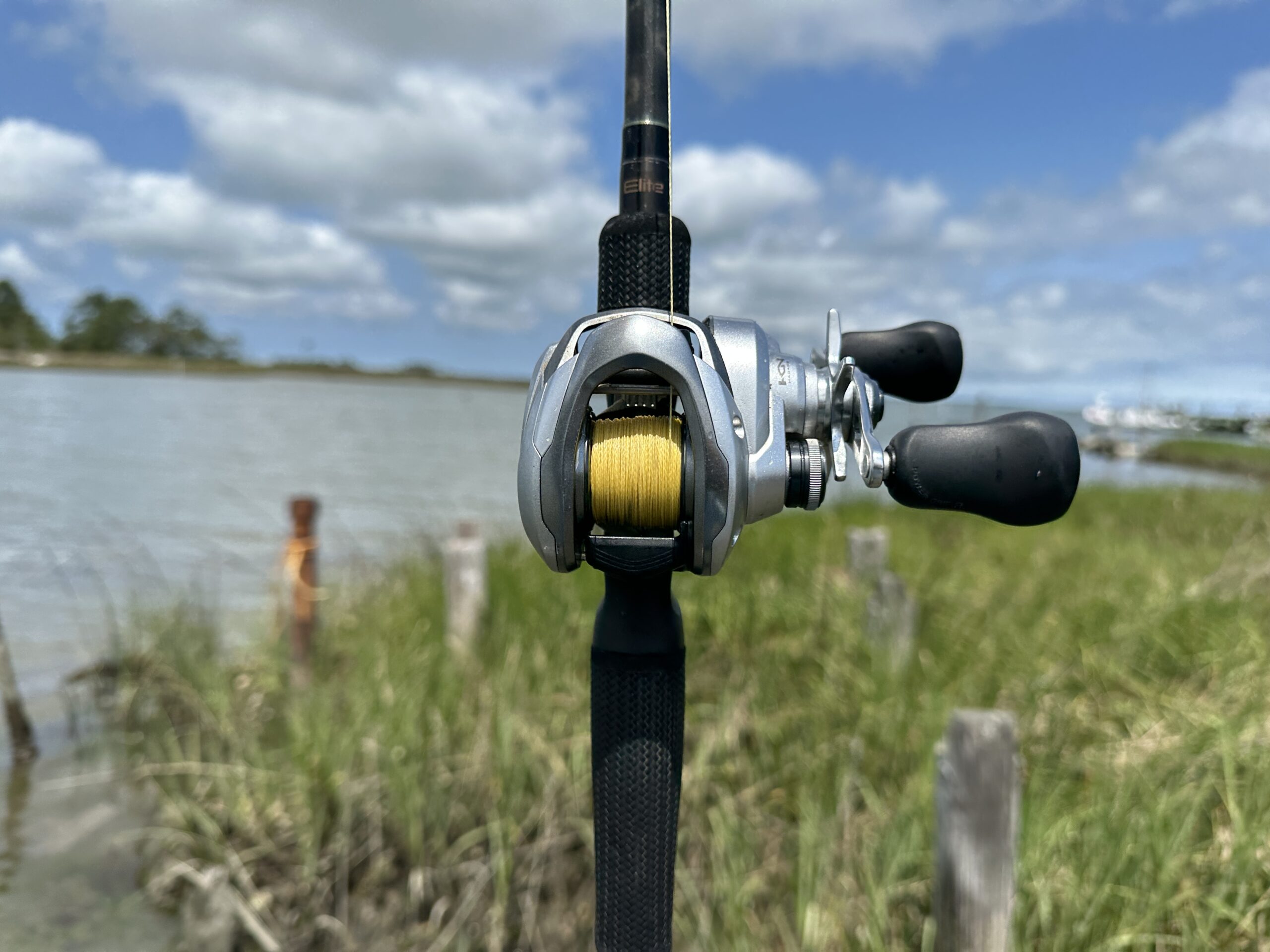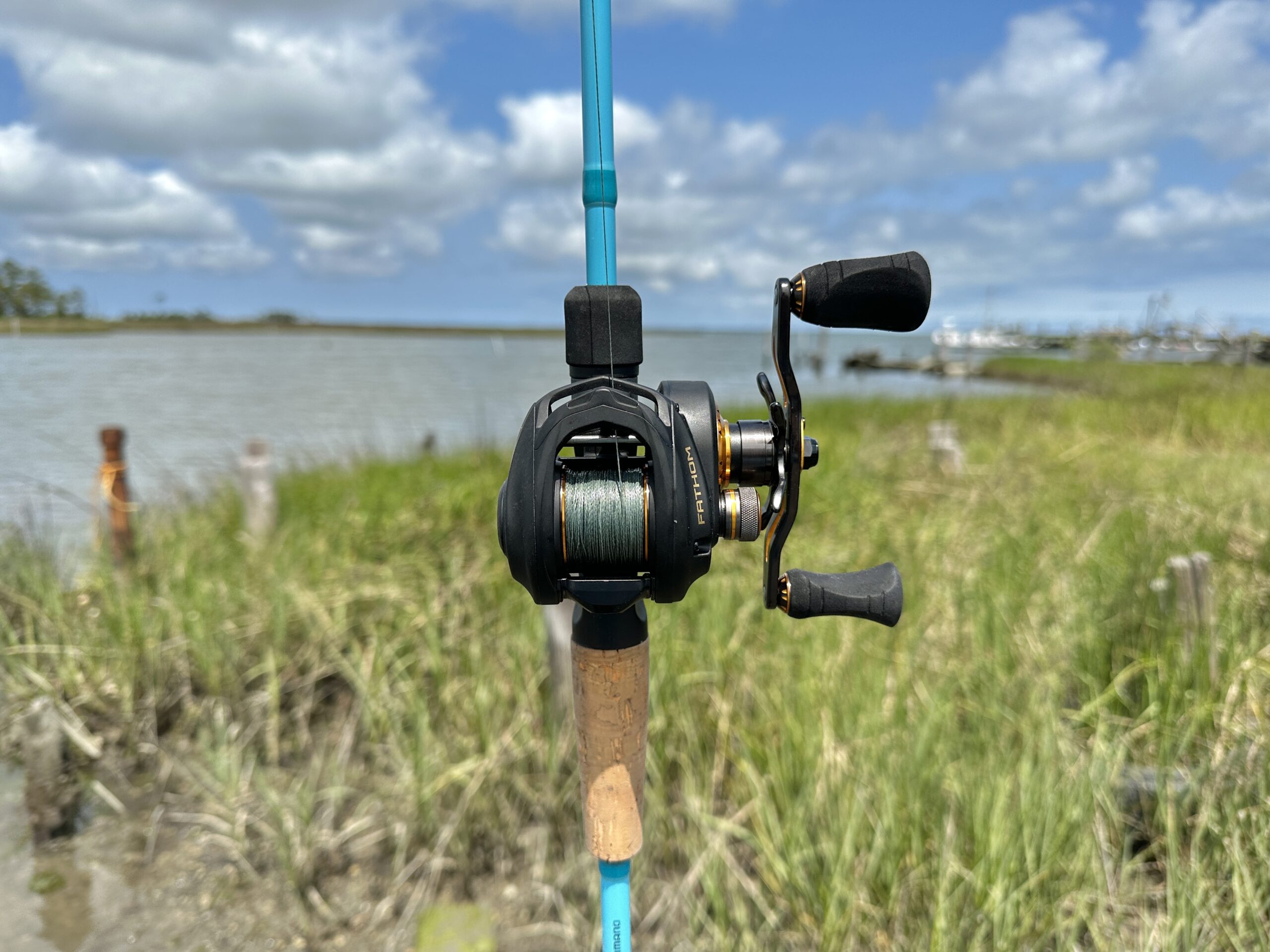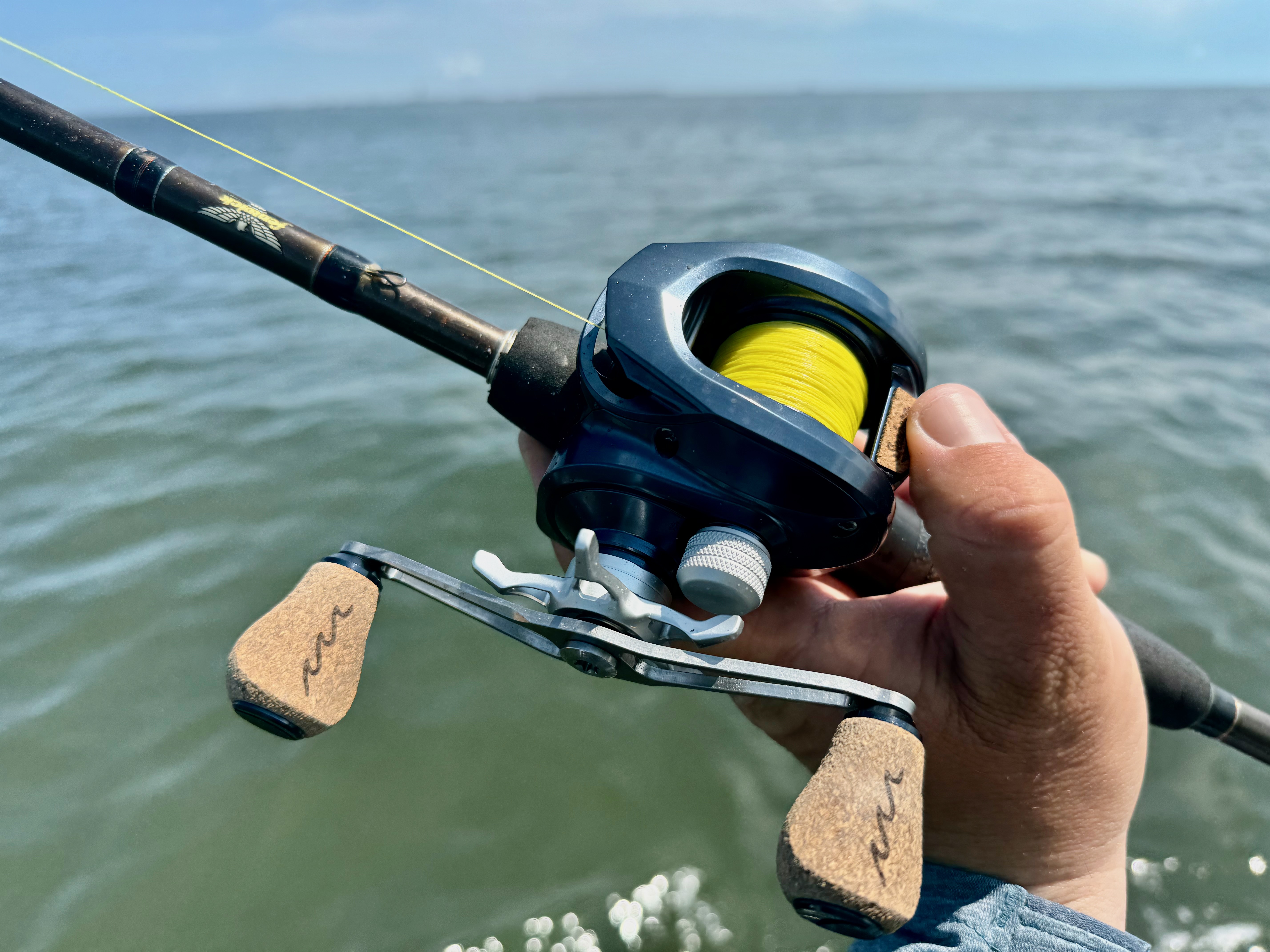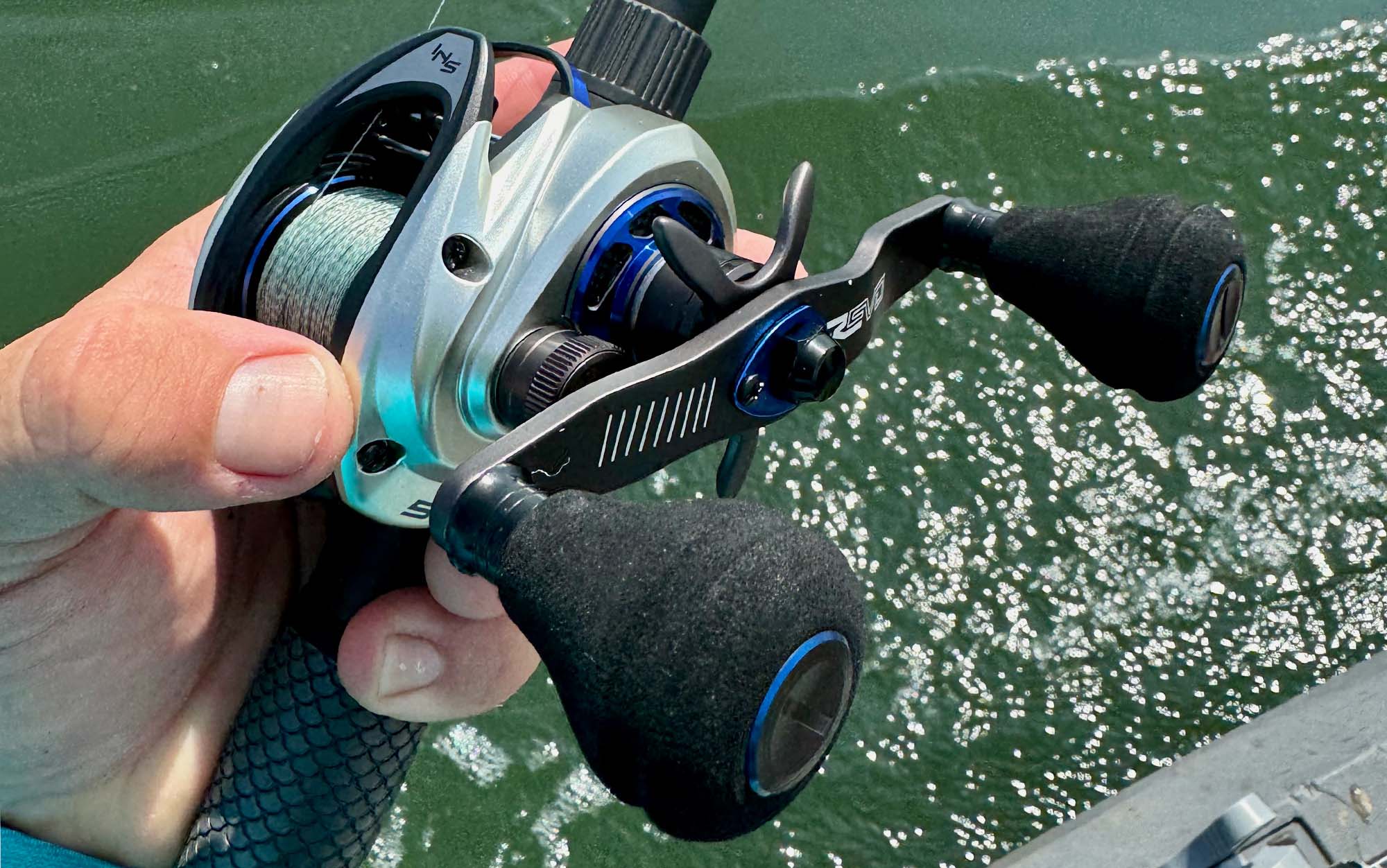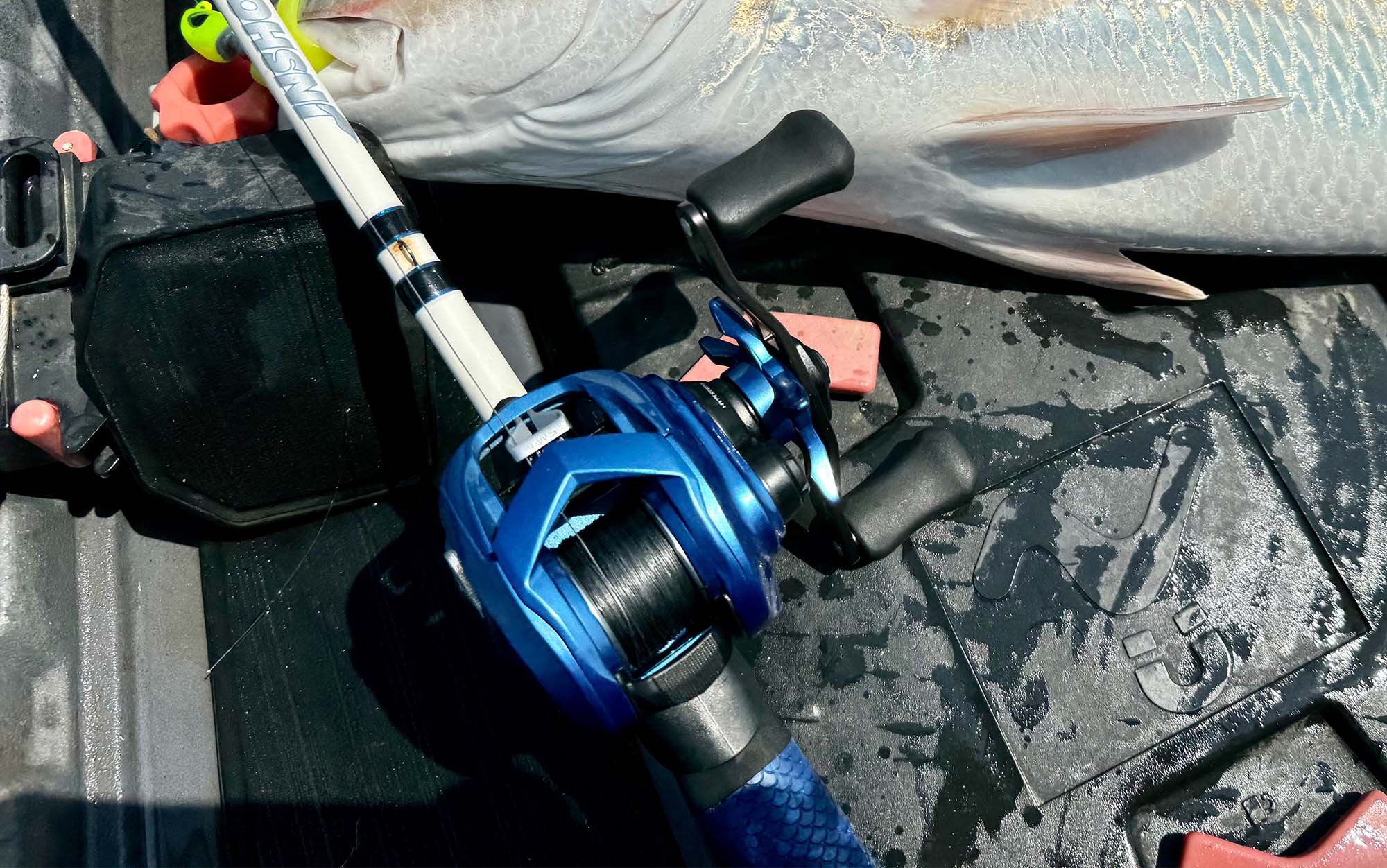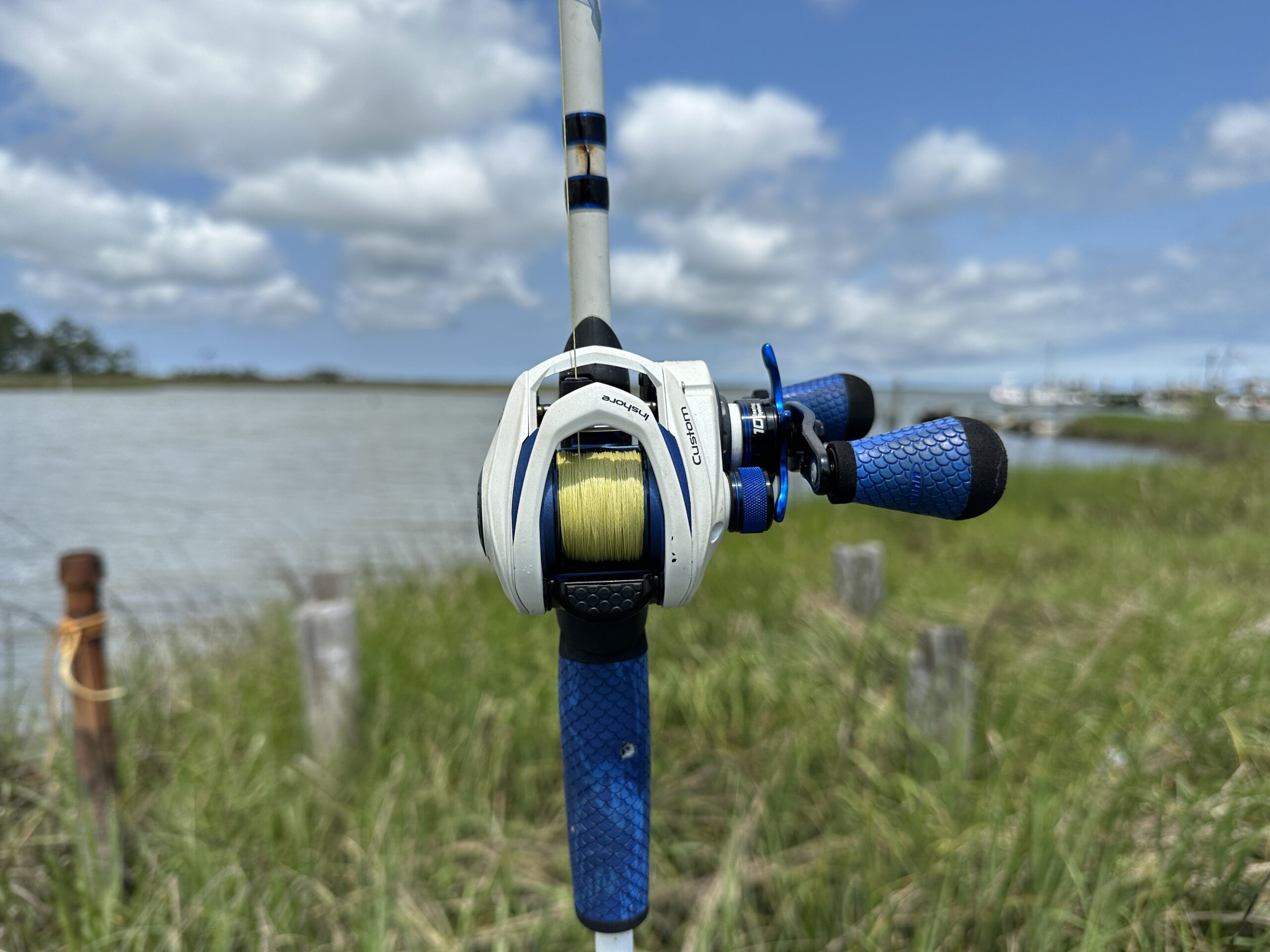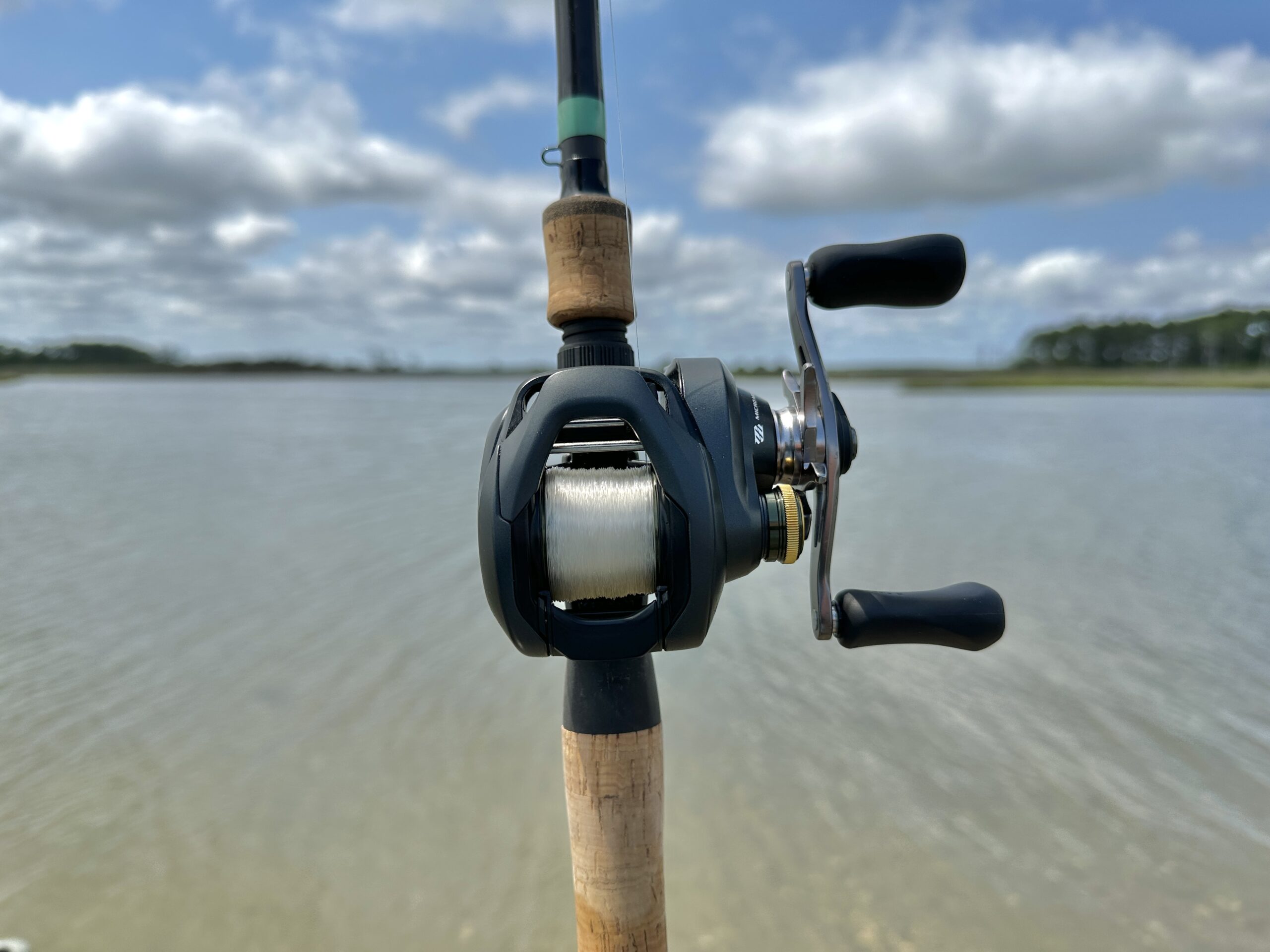The Best Saltwater Baitcasting Reels of 2024, Tested and Reviewed
We may earn revenue from the products available on this page and participate in affiliate programs. Learn More ›
While I’m sure plenty of our West Coast saltwater anglers will disagree, the reality is that baitcasters have been made and marketed primarily for the freshwater world for quite some time. Sure, you’d find the occasional angler dedicated to using them, but most inshore guides and anglers had a quiver full of spinning gear and not much else.
Today a renaissance of sorts is happening in the inshore angling world. New materials and high-end machining techniques have paved the way for low-profile baitcasters that are not only built for heavy saltwater use but excel in it. Slowly but surely, low-profile baitcasters have found their way into the regular rotation of many inshore anglers. Modern inshore gurus like Captain C.A. Richardson have embraced them to the point where they rarely use spinning gear.
With this new age of inshore baitcasters has come a bevy of reel options on the market. Finding the right low-profile baitcaster can be challenging, and making the wrong choice could lead to a disastrous day on the water. To help you make that decision, I tested many of the top low-profile saltwater baitcasters on the market and sat down with guides and anglers who use them daily. Through this process, I’ve compiled a list of the best saltwater baitcasting reels for every type of salty situation you might encounter.
- Best Overall: Shimano Tranx
- Best for Jigging: Penn Fathom
- Best Heavy-Duty Inshore Reel: Bates Salty 150
- Best for Speed Fishing: Abu Garcia Revo Inshore
- Best Compact: Daiwa Coastal SV TW 150
- Lew’s Custom Inshore
- Shimano Curado K
How I Chose the Best Saltwater Baitcasting Reels
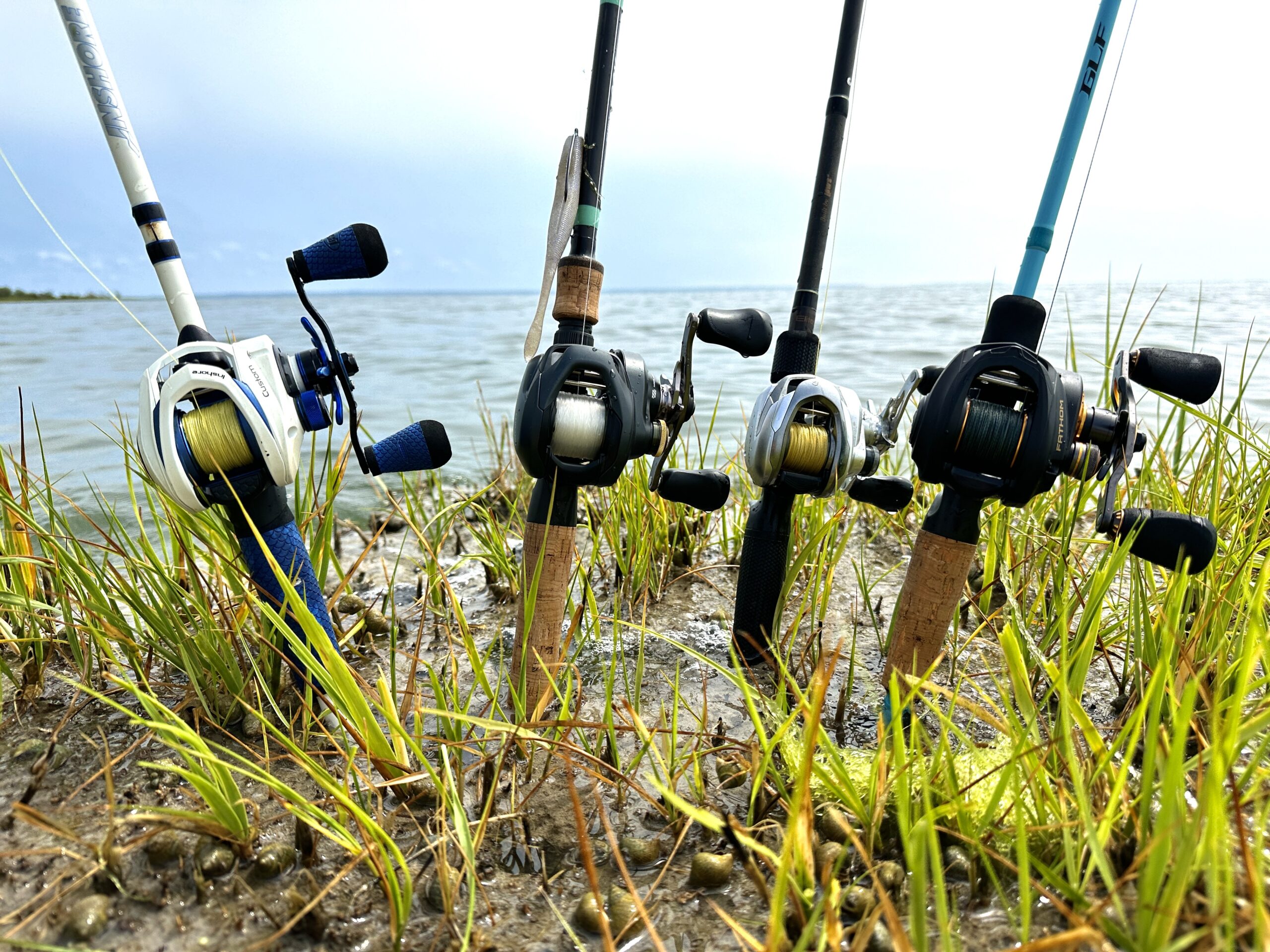
Having spent most of my life fishing saltwater from Texas up through Virginia and everything in between, I’ve seen firsthand what happens when reels get exposed to salt over time. This experience helped me better evaluate the reels we tested, looking for key qualities and specs that made them suitable for the task. Components such as drag material, gearing, and frame material were critical. Functionality like drag pressure, brakes, and retrieve ratio were also key factors for consideration.
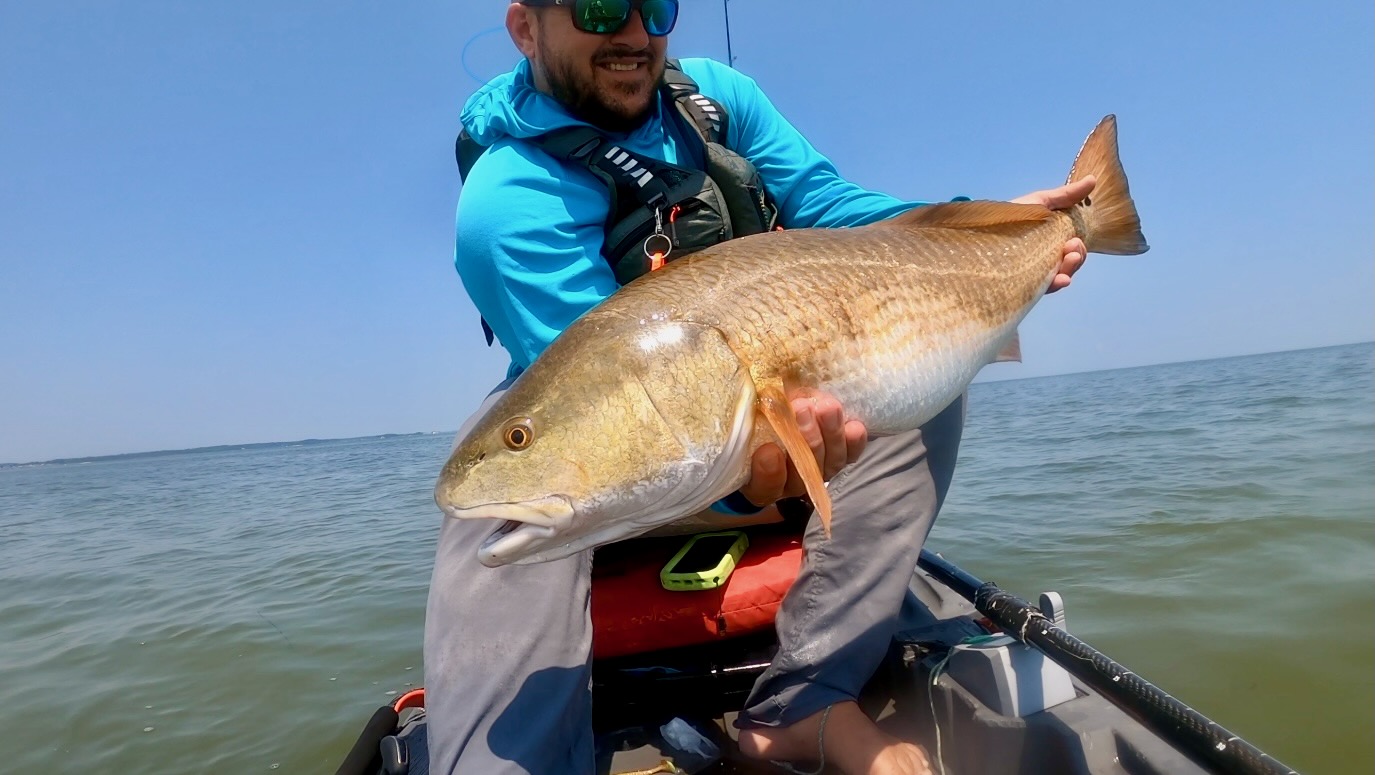
Kevin Hughes
Of course, specs only take you so far, so I also put these reels through the paces with real-world testing. Over several months, these reels got used in a variety of inshore environments, from the marshes of the Outer Banks in North Carolina, the flats of Biscayne Bay and the Everglades in Florida, and the oyster-filled backwaters of the Chesapeake Bay in Virginia. We caught everything from speckled trout and redfish to snook, tarpon, and striper. Through this process, gear editor Scott Einsmann and I were able to dial in just what makes these reels tick and what they are each best suited for during a day on the water. Using that knowledge and interviews with inshore baitcaster experts like Captain C.A. Richardson of “Flats Class TV,” I compiled this breakdown to help you understand what to look for when choosing a low-profile reel.
Best Saltwater Baitcasting Reels: Reviews and Recommendations
Best Overall: Shimano Tranx
Key Features (150HG size)
- Weight: 6.7 ounces
- Line Capacity: 150 yards of 20-pound braid
- Bearings: 3+1
- Max Drag: 13 pounds
- Gear Ratio: 7.2:1
- MSRP: $219.99
Pros
- Extremely durable
- High-end gearing and seal
- Lightweight
- Smooth
- Large range of sizes (150-500)
Cons
- Limited drag strength
- Limited tuning ability
The Tranx lineup from Shimano has gained a well-earned reputation for withstanding anything thrown at them. The smallest reel in the series, the 150, is no exception. Despite its lightweight and smaller size, this reel still feels rock solid in your hand. It’s designed to cast and fight fish in the salt all day, every day.
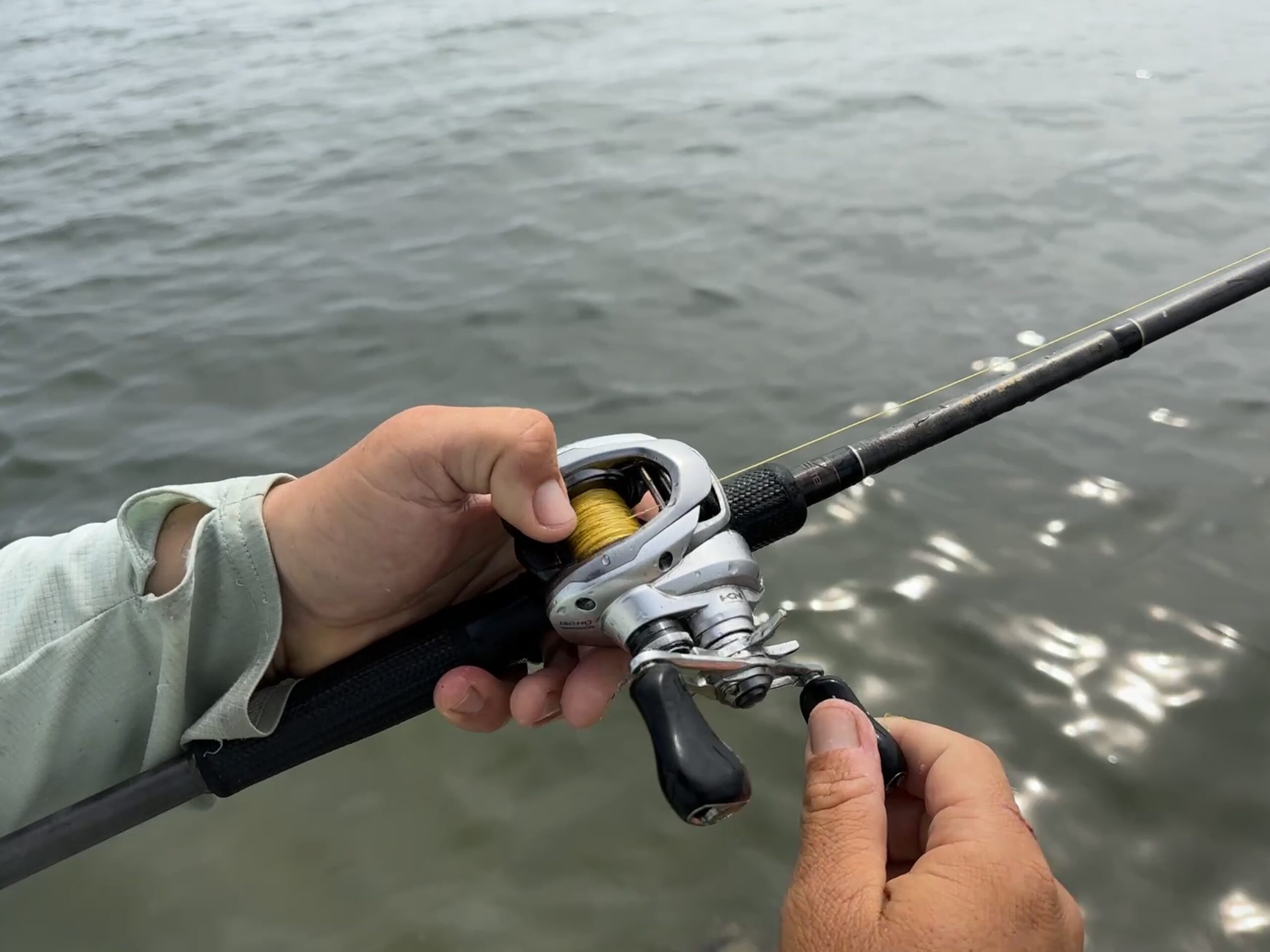
The Tranx 150 is a reel for anglers pushing their gear to the limits. It lacks some of the smoothness and featherlight feel of the Chronarch G, but it more than makes up for its durability. The delicate internal components are housed within a rigid metal frame that prevents flex and warping, making this reel ideal for intense fights and long days on the water. It also utilizes Shimano’s CoreProtect technology, which is a protective coating that prevents corrosion and adds extra strength to the core components of the reel.
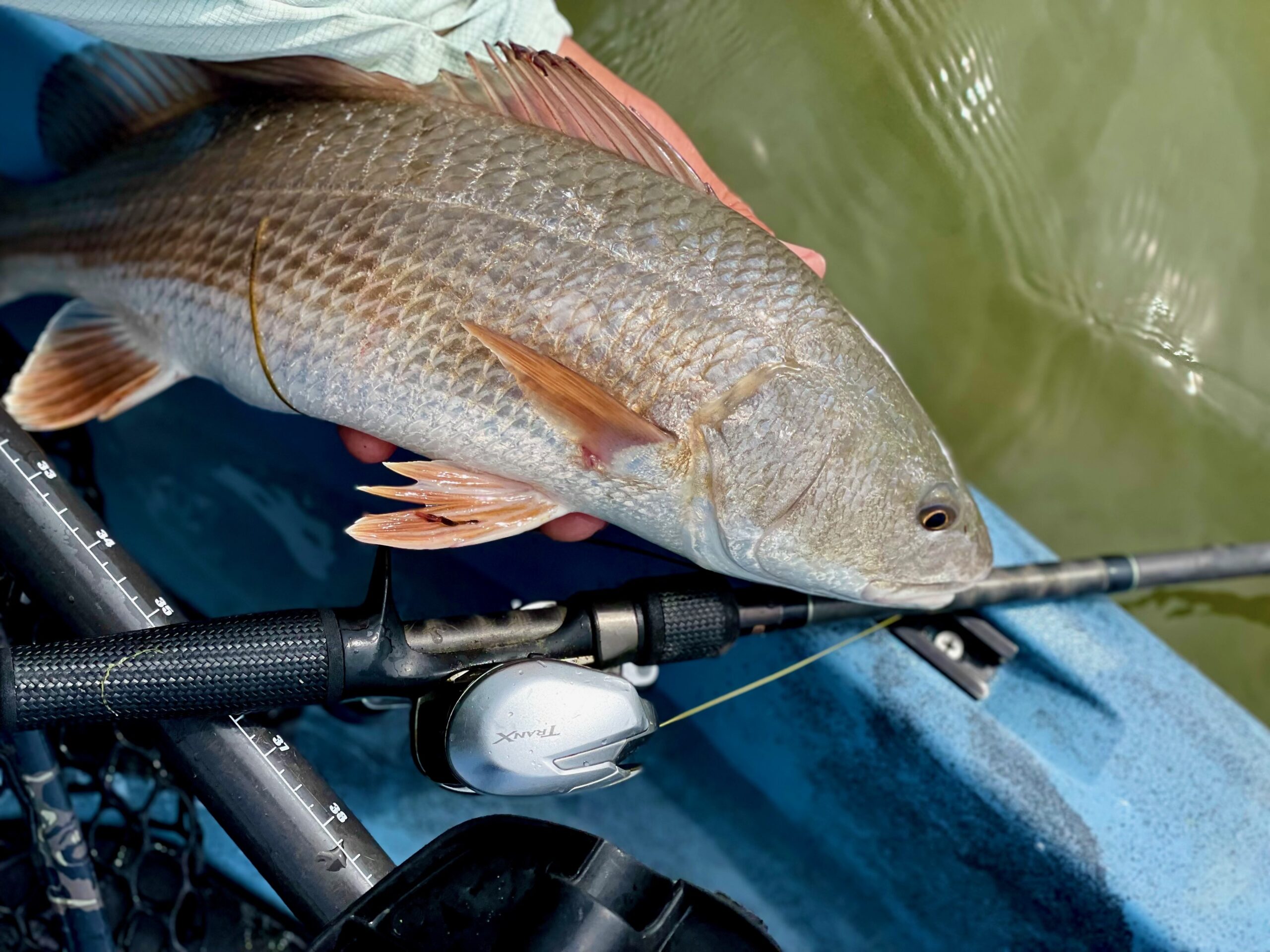
While the reel does boast a smooth carbon dag, the stopping power is somewhat lacking at 13 pounds. That’s not terrible, but it is a little less than one would expect for a reel designed with such heavy-duty use in mind. That said, this reel will have more than enough power for most inshore applications. Additionally, the Tranx comes in several sizes, from 150 all the way up to 500. The 150 is ideal for inshore casting applications, the 300 is perfect for bucktailing fluke and throwing big topwaters for stripers, and the 400 size with the power handle is the best saltwater baitcasting reel for deep jigging. The larger sizes provide significantly more drag and are a great option for expanding beyond light inshore use.
Read Next: Best Saltwater Fishing Rods
Best for Jigging: Penn Fathom
Key Features (300 size)
- Weight: 9.2 ounces
- Line Capacity: 310 yards of 20-pound braid or 240 yards of 12-pound mono
- Bearings: 6+1
- Max Drag: 30 pounds
- Gear Ratio: 7.3:1 or 9.2:1
- MSRP: $269.95
Pros
- Extremely strong drag
- Impressive gear ratios and retrieve rate
- Incredible line capacity
- Large range of sizes/specs
Cons
- Very heavy
- Lacks finesse
Penn has long been a staple in the saltwater world, with its line of spinning and conventional reels setting the standard for balancing cost with performance. Despite this, they’re relatively new to the low-profile baitcaster scene, but you’d never know it after using the Fathom. This reel is packed with all the quintessential Penn traits that make it feel like a true saltwater tool while still maintaining an impressive balance and comfort that are essential to low-profile reels. It’s a powerful, comfortable reel ideal for cranking on big fish at depth.
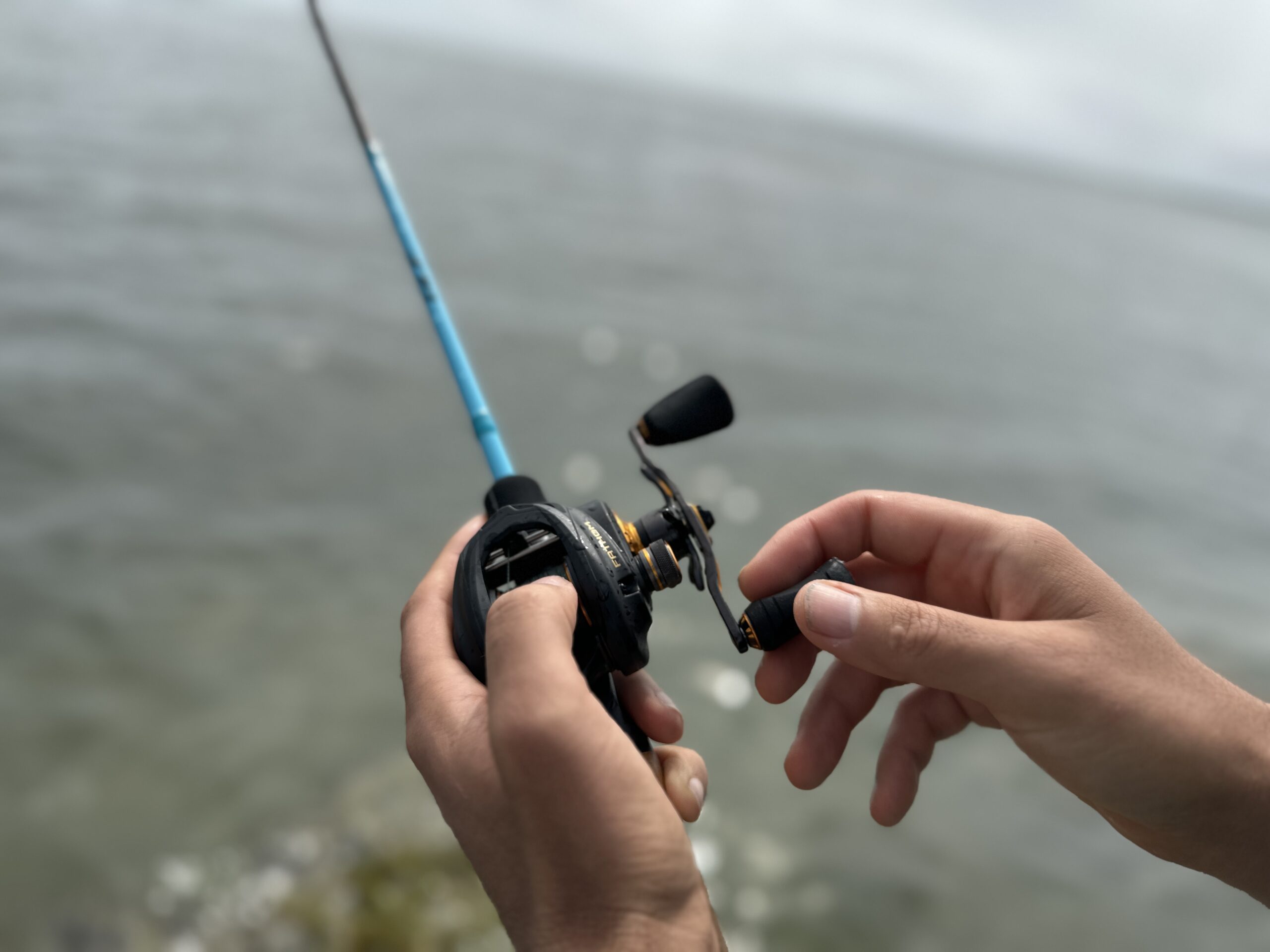
With a full metal body and beefy frame, the Fathom feels like a workhorse. This saltwater baitcasting reel boasts 30 pounds of drag strength, it’s easily the top of this list when it comes to pulling ability. With the 9.2:1 ratio model also reeling in a ridiculous 43 inches of line per crank, this reel is tailor-made for jigging and bottom fishing. Add to that the enormous line capacity, and you have a reel that can winch up powerful fish at depth.
All that power and strength does come at a cost, unfortunately. This reel is much heavier than other reels in the class, making it tough to imagine casting all day long. It also lacks the smooth feel and finesse qualities of the other inshore low-profile reels on this list. Ultimately, this reel is designed with jigging in mind, and that’s where it will excel.
A unique combination of power, torque, and comfort, the Fathom is a versatile option for anglers looking to fish inshore to nearshore wrecks and reefs.
Read Next: Best Saltwater Spinning Reels
Best Heavy-Duty Inshore Reel: Bates Salty 150
Key Features
- Weight: 8 ounces
- 150 size
- Brass gearing
- CNC-machined aluminum, one-piece body
- Stainless steel and titanium water-tight drag
- Line Capacity: 190 yards of 30-pound braid
- 7.1:1 and 6.3:1 gear ratios
- Bearings: 10+1 stainless steel with anti-corrosion coating
- Max Drag: 20 pounds
- Cork grips
- MSRP: $329.99
Pros
- One-piece aluminum body is extremely durable and resistant to flex
- Good line capacity and drag
- High-end gearing and seal
- Smooth
Cons
- Slightly heavy
- Expensive
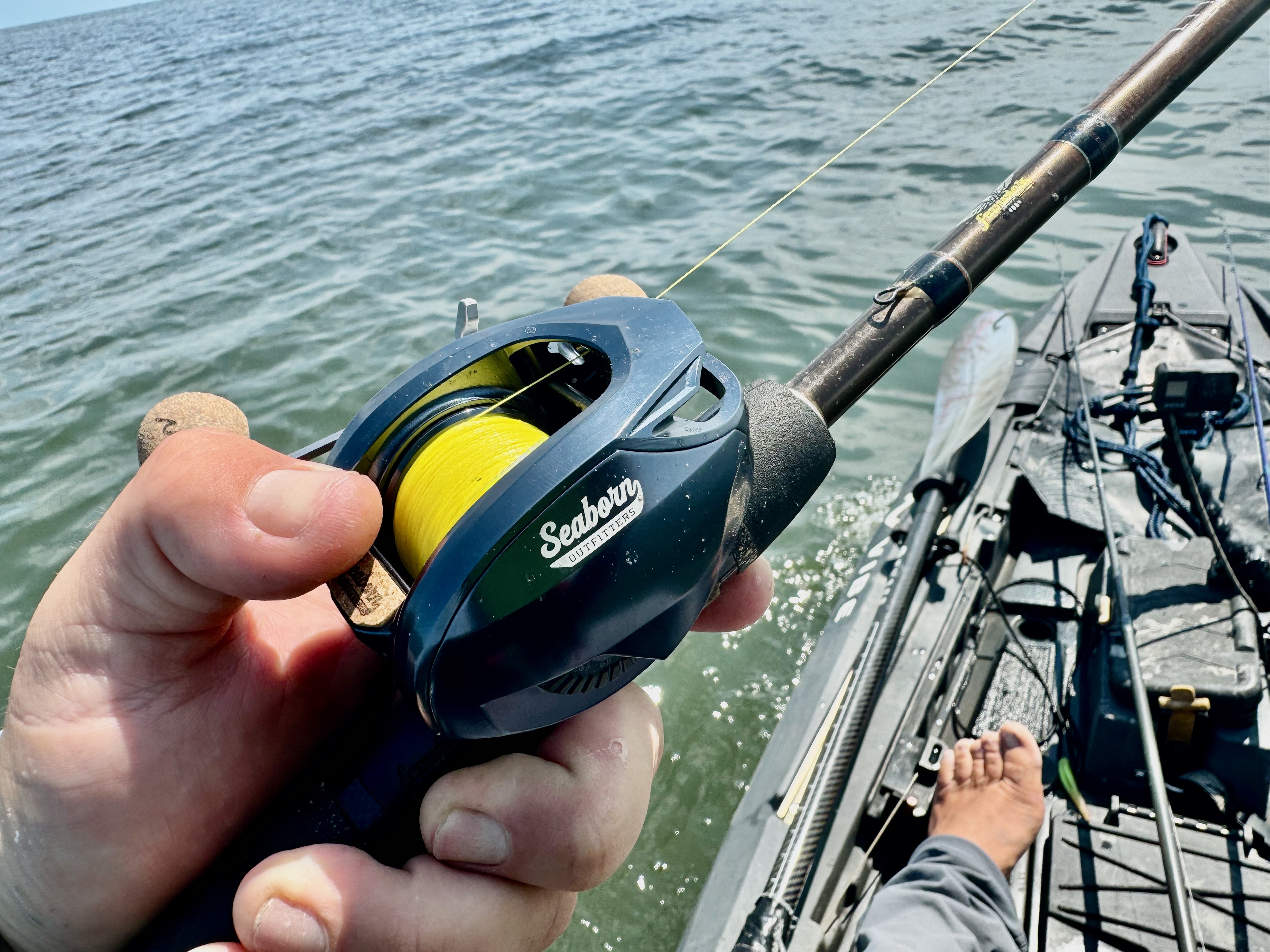
Kevin Hughes
Bates is a relatively new reel company, but its predecessor, Seaborn, is a respected name in the Texas fly and inshore game. Bates specializes in manufacturing reels designed for specific purposes and that are machined out of a single piece of aluminum bar stock, something almost unheard of when it comes to low-profile baitcasters. This machining process increases durability and makes the reels very rigid.
At first glance, the Salty 150 nails the presentation element. The deep gray-blue anodized finish and aluminum handle with laser engraved cork grips make for a striking reel. While it’s a pretty reel, the Salty 150 shines once you get it on the water. I could immediately feel the rigidity and strength of the machined aluminum frame, especially compared to my reels with polymer and carbon frame components. The frame and handle had almost no flex when I was fighting powerful cobia and reds. This reel’s torque is incredibly impressive, allowing you to beat the strongest inshore gamefish relatively quickly.
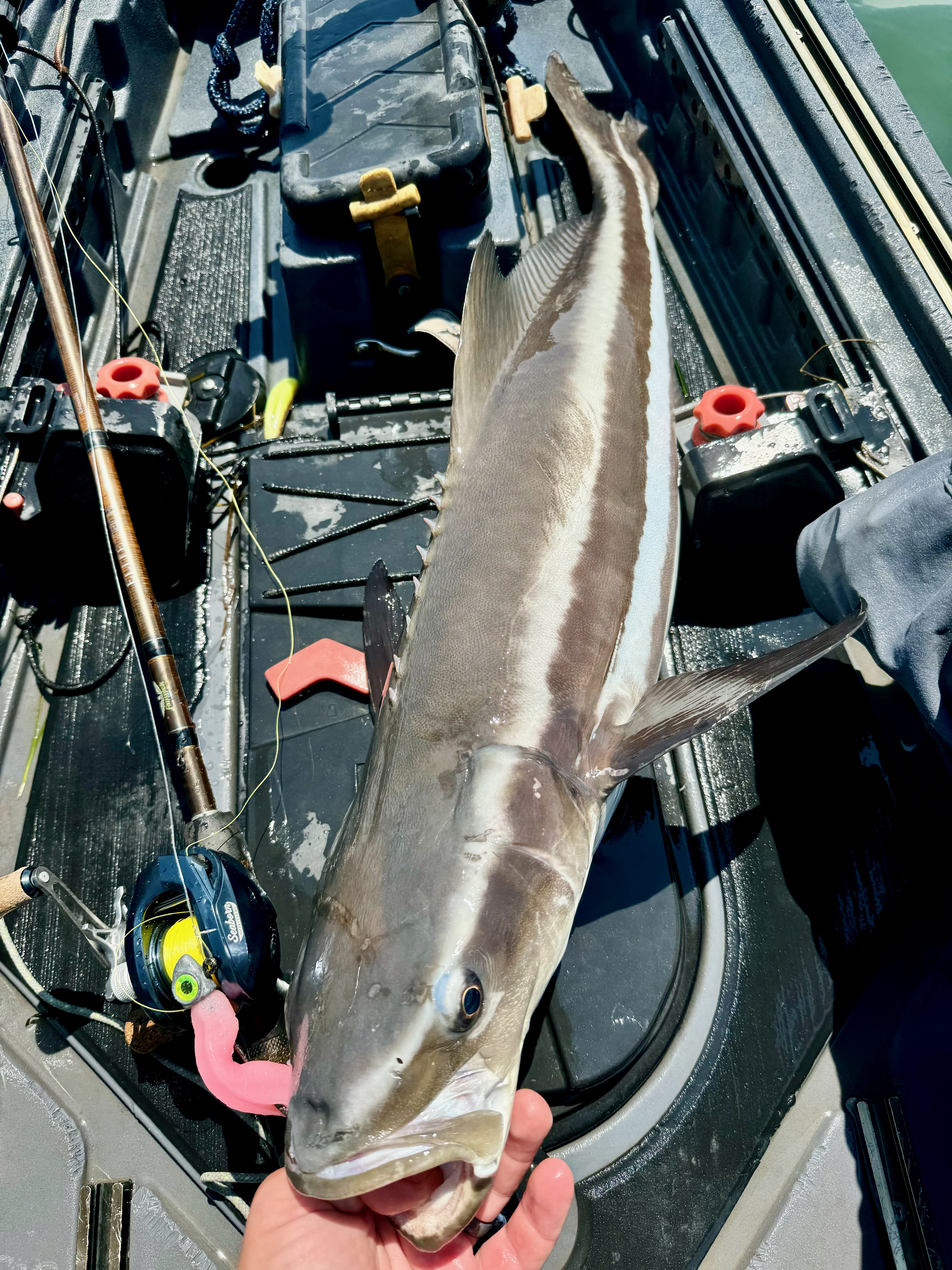
Kevin Hughes
While I love this reel, I will admit that it has a utilitarian, old-school feel that may not be for everyone. Modern low-profile baitcasters tend to be technology-heavy lightweight operations, something that the Bates Salty 150 is decidedly not. If you’re looking for a high-tech reel with all the newest features, the Salty 150 probably isn’t your cup of tea. That said, if you want a reel that you can use for many seasons that’s comfortable and has high-end performance, the Salty 150 absolutely fits the bill. The incredibly rigid and durable machined aluminum frame, combined with 20 pounds of drag and a solid line capacity, makes this reel a dominant force for inshore anglers looking for a heavy-duty option in a palm-sized package.
Best for Speed Fishing: Abu Garcia Revo Inshore
Key Features
- X2-Cräftic alloy frame
- Oversized aluminum handle with large EVA foam knobs
- Powerstack carbon drag system
- Line Capacity: 175 yards of 30-pound braid
- 7.3:1 gear ratio
- 32 inches of line retrieve per crank
- Bearings: 5+1 stainless steel
- Max Drag: 26 pounds
- MSRP: $249.95
Pros
- Oversized handle and gear ratio provides a ridiculous 32 inches of line per crank
- Strong drag
- A lot of power in a palm-able design
- Smooth
Cons
- Lots of connection points that could allow grit and salt entry over time
The new Abu Garcia Revo Inshore is a power angler’s dream. Right out of the gate, I was struck by the oversized handle and large EVA foam grips, which may appear too large for the frame but are quite balanced when used. This handle, combined with a 7.3:1 gear ratio, gives the reel a ridiculous 32 inches per crank line retrieval rate, making it ideal for speed-jigging spoons or burning swimbaits through schooling fish. The Revo Inshore does an impressive job of melding finesse and comfort into its powerful design, utilizing an asymmetrical alloy frame to give you a palm fitting reel that’s surprisingly light. This reel also features Abu Garcia’s IVCB-6 braking system and Power Stack Carbon Matrix drag, which both provide an exceptional amount of fine-tuning ability, as well as an impressively smooth feel when casting or fighting fish.
The Revo inshore uses components that are pieced together to create a complex overall design. That may not necessarily be a bad thing, but it does provide many seams and load-bearing points, which could contribute to wear and tear with extended use. That said, this reel is too new to say with certainty how it will break down over time, and I’ve been nothing short of impressed with its performance thus far. The new Revo Inshore is an excellent option for anglers who like to run-and-gun after schooling fish like false albacore and striped bass.
Best Compact: Daiwa Coastal SV TW 150
Key Features
- Weight: 6.9 ounces
- 150-size spool in a 100-size body
- Aluminum frame and side plate
- Carbon drag
- Line Capacity: 165 yards of 30-pound braid
- 7.1:1 and 8.1:1 gear ratios
- Bearings: 2CRBB+5BB+1
- Max Drag: 11 pounds
- MSRP: $269.99
Pros
- Incredibly compact
- Aluminum frame is durable and lightweight
- Smooth
Cons
- Limited drag
Daiwa built the Coastal SV TW 150 specifically for Gulf Coast redfish and speckled trout. Anglers in that region use lighter tackle, so the Coastal SV TW was built with a 100-sized body, yet it has a deeper, 150-sized spool. This interesting combination makes for a reel that’s compact and easy to fish while still dishing out an impressive amount of power when necessary.
As an inshore angler who commonly targets redfish and speckled trout in Virginia, this reel rose to the top of my rotation. I found it particularly enjoyable for fishing finesse jig presentations and twitchbaits, as its small size and gear ratio allowed it to impart good action with minimal effort. Its size and palm-ability also made it comfortable to fish for extended periods of time.
You can get the Coastal SV TW with a 29.8-inch line retrieval rate or a gaudy 33.9-inch retrieval rate. While this reel has a similarly impressive line retrieval to the Abu Garcia Revo Inshore, the Daiwa Coastal SV TW is built with an entirely different mindset. Featuring a smaller 100mm handle and frame, this reel’s retrieve speed is intended to impart action and finesse into your presentation, something especially appealing to speckled trout and redfish anglers. The aluminum frame and side plate also provide excellent corrosion resistance for anglers who prefer to wade fish.
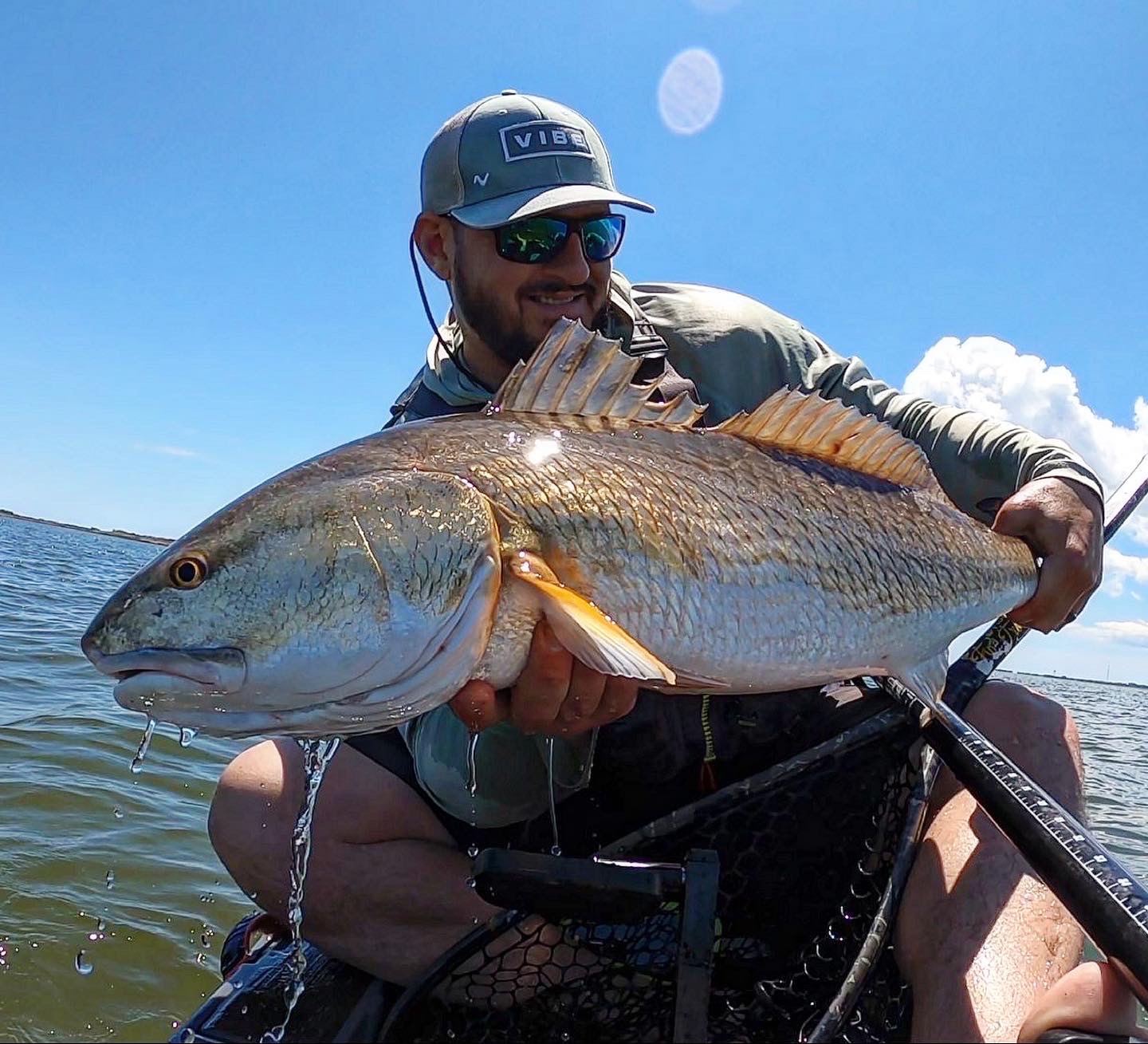
Read Next: Best Saltwater Fly Rods
Lew’s Custom Inshore
Key Features (CI1SH model)
- Weight: 6.9 ounces
- Line Capacity: 140 yards of 50-pound braid, 140 yards of 12-pound mono
- Bearings: 9+1
- Max Drag: 20 pounds
- Gear Ratio: 7.5:1
- MSRP: $219.99
Pros
- Strong drag
- One-piece aluminum frame
- Lightweight
Cons
- Not very smooth
- Limited size range
Despite being known as a primarily freshwater brand, Lew’s has ventured into the saltwater world with the Custom Inshore lineup. The Custom Inshore baitcaster is a solid, quality reel. It’s a great inshore reel for someone just dipping their toe into the saltwater baitcaster game.
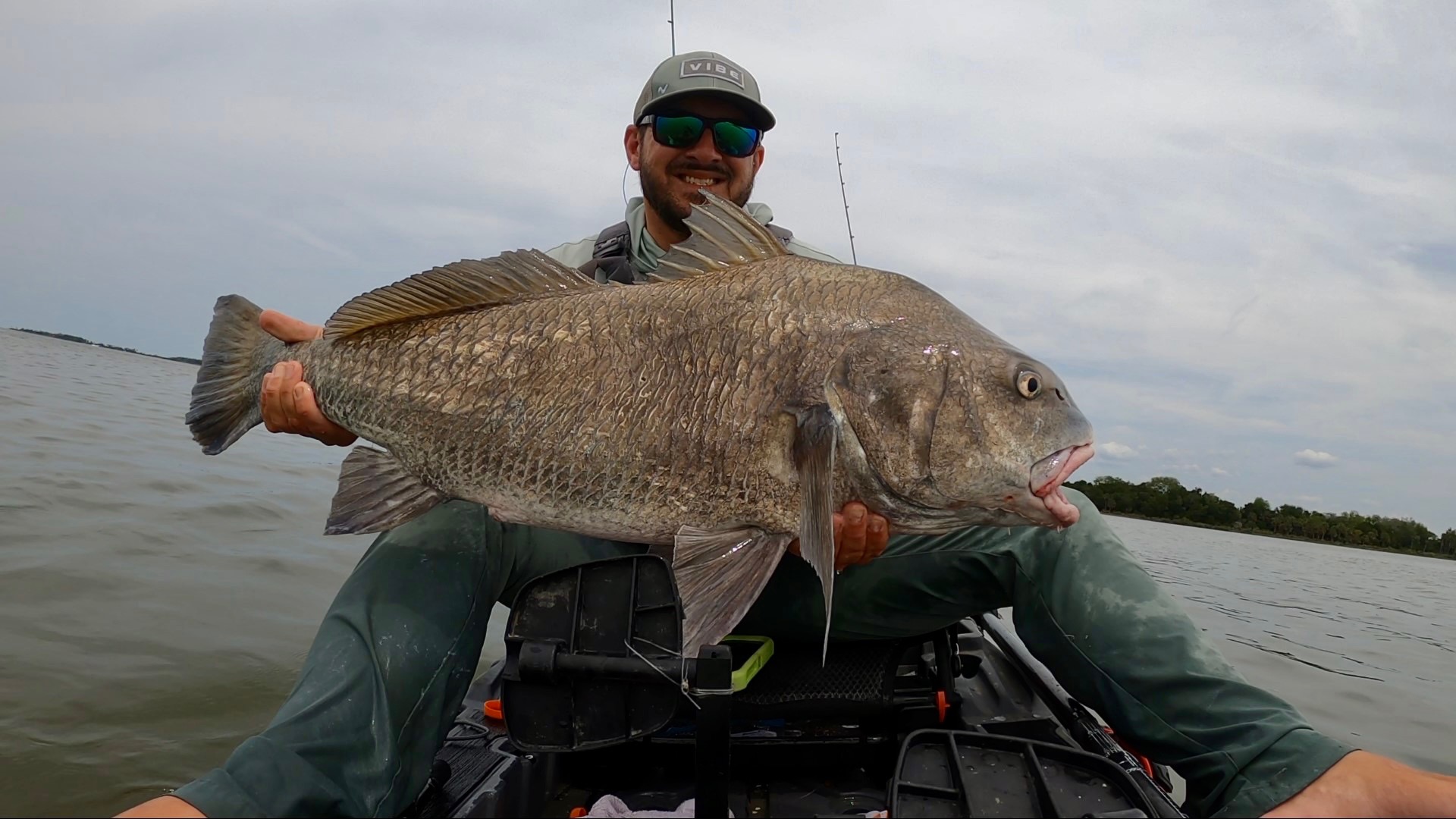
Lew’s has always been known for providing anglers with quality gear at lower-than-average prices. The Custom Inshore reel is their attempt at doing this for the saltwater angling crowd, and it accomplishes that goal well enough. Made of anodized aluminum with a carbon sideplate on the handle side and graphite sideplate for palming, the frame is durable enough to withstand abuse. The carbon fiber drag system is a highlight, providing a remarkable 20 pounds of drag. This reel also provides a relatively high line capacity for a low-profile inshore reel, allowing it to be used for a wider range of applications inshore.
While the drag is smooth, the casting and retrieving feel slightly clunky. Additionally, while the reel isn’t technically very heavy, its balance and frame feel a bit ungainly in the palm when compared to some of the more expensive reels on this list. Despite the drawbacks to this reel, the positive features more than balance it out. While I don’t recommended it if you plan to cast all day, the Lew’s Custom Inshore is the perfect option if you’re looking for a quality reel for casual use.
Shimano Curado K
Key Features (200HGK model)
- Weight: 7.6 ounces
- Line Capacity: 190 yards of 30-pound braid, 155 yards of 10-pound mono
- Bearings: 6+1
- Max Drag: 11 pounds
- Gear Ratio: 7.4:1
- MSRP: $199.99
Pros
- Good line capacity
- Good range of sizes and gear ratios
- Reasonably priced
- Smooth
Cons
- Limited drag capacity
- Heavier than similar models in class
The Curado series is one of Shimano’s mainstays, building a reputation for reliability over the years. The lineup is a staple for many anglers, and the most recent iterations should do nothing to change that. The Curado is a solid, reliable, and comfortable reel at a reasonable price point.
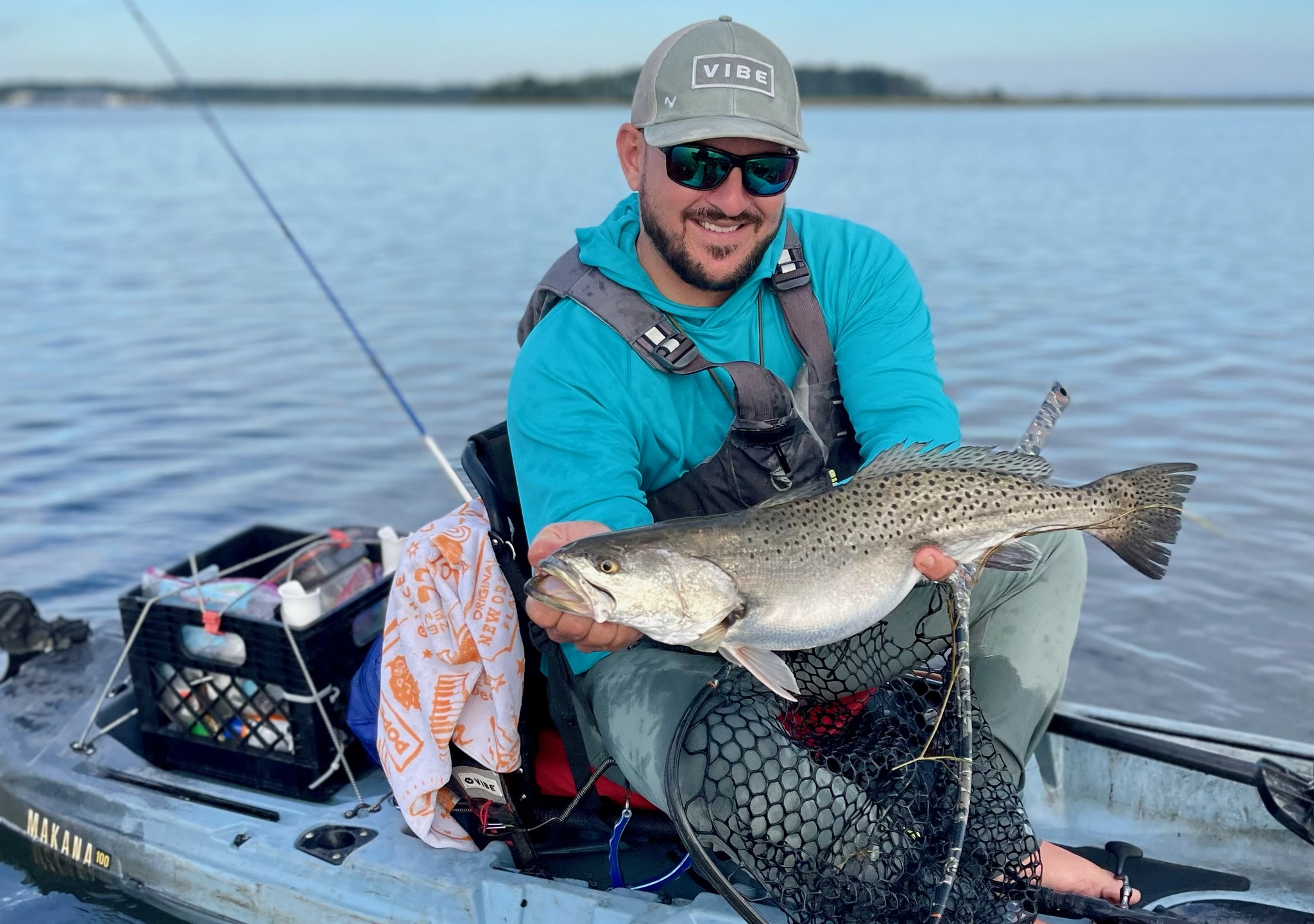
The Curado K series comes in a wide range of sizes and gear ratios, making it a versatile option for anglers looking to get into the low-profile saltwater game. It features many of the same high-end technology found in the pricier Shimano reels on this list, including MicroModule gearing, X-Ship, and the SVS Infinity braking system. The Curado K is also slightly smaller than previous versions, making it a very comfortable reel to fish and allowing for a high degree of control.
While the more modern options in Shimano’s lineup, like the Tranx, have started to steal the show somewhat, the Curado’s reputation and quality will always have a place for many anglers. Simply put, it’s a quality reel that has very little downside at a reasonable price. I think the Curado K is the best saltwater baitcasting reel for someone who bass fishes some weekends and fishes inshore fishes on others.
How to Choose a Saltwater Baitcasting Reel
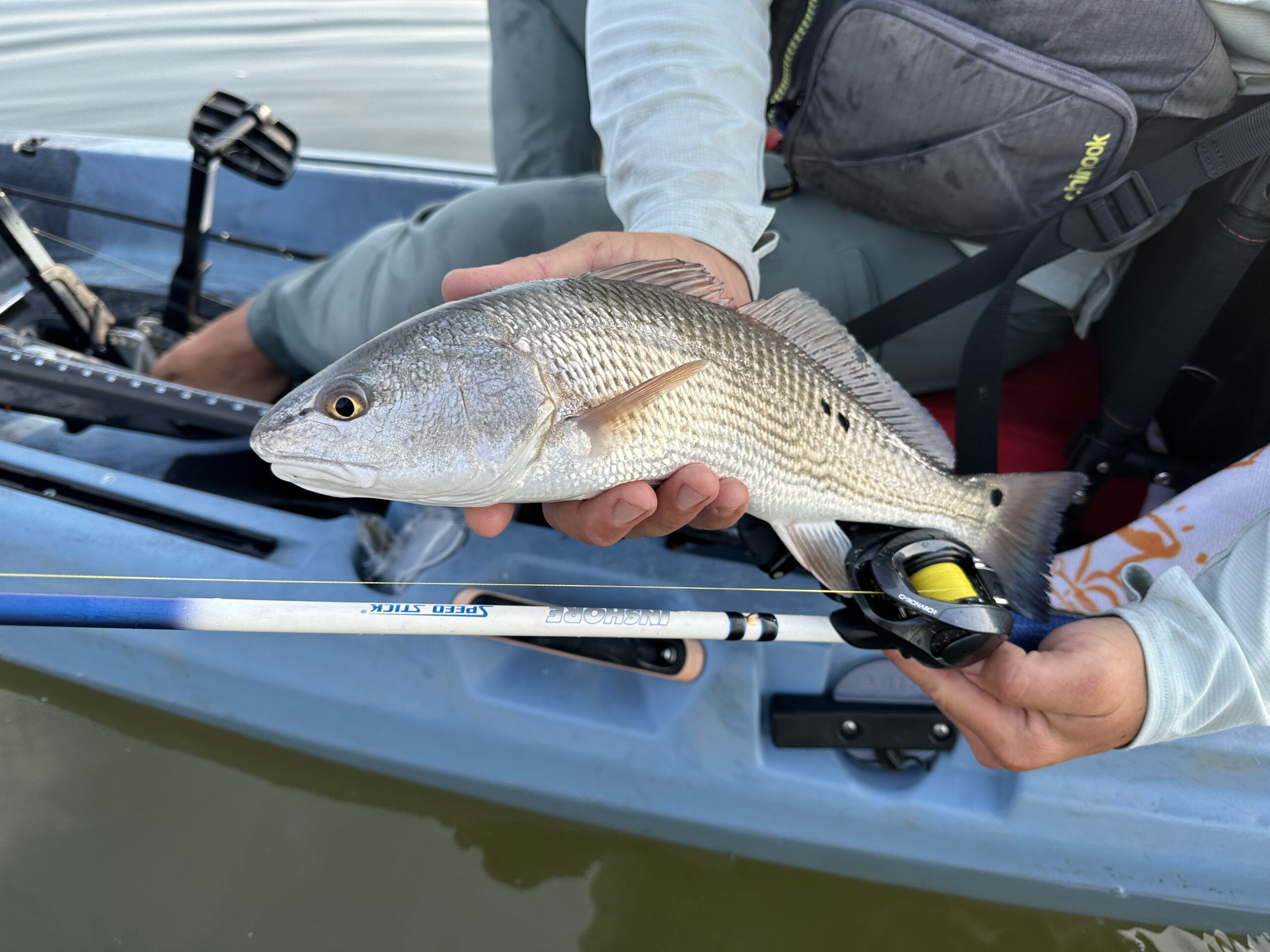
Spinning reels became the standard inshore reel for saltwater for many reasons, but simplicity was a big factor. While having loads of dials and gears allows for baitcasting reels to be fine-tuned, they also leave the reels vulnerable to breaking down in ways that most spinning reels simply aren’t.
Interestingly enough, that wasn’t always the case. For years, the original Everglades angling pioneers, legends like Flip Pallot, preferred to use baitcasters on short pistol-grip rods. These were the ideal tools to dissect the mangroves and wench trophy snook and tarpon from their hiding places. At some point, these setups fell out of favor, and the era of low-profile baitcasters inshore seemed to be no more.
Fast-forward to today, and that’s no longer the case. Modern baitcasters have surged in popularity and revolutionized the inshore game. However, choosing one can be a little trickier than purchasing a spinning setup. Despite their complex nature, the key factors for choosing a baitcaster are essentially the same as any other saltwater reel.
The right choice is usually decided by how often you’ll be using it and what you’ll be using it for. If you’re targeting hard-fighting fish like snook on a regular basis, things like drag strength and retrieve ratio are more important. If you’re only getting out a few times a year after less formidable species like speckled trout, something that’s lighter and more comfortable to cast may be a better choice.
Then there is the salt factor. Unlike bass fishing, inshore baitcasters need to be able to withstand the elements at a much higher level. Salt corrodes everything it touches, and a complex bit of machinery like a baitcaster can be extremely vulnerable to deterioration. Corrosion-resistant materials and a quality seal are at the top of the list of important features to consider.
FAQs
Captain C.A. Richardson primarily uses low-profile reels inshore, and he was able to shed some light on many of their benefits. u0022They offer a much greater degree of control over your lure,u0022 Richardson says. u0022The ability to dictate the lure speed and action is light years ahead of what can be done with spinning gear.u0022 He was also adamant about casting accuracy being critical, and a low-profile baitcaster allows him to put lures where they need to go faster and easier than a spinning reel would. Lastly, Richardson brought up the many line-related benefits of using a low-profile baitcaster. He’s an advocate for using fluorocarbon lines on his reels, as it allows for stealthier presentations to spooky fish. u0022You can’t spool a spinning reel with straight fluorocarbon,u0022 he says, u0022it’ll twist and shoot off the spool, leaving a tangled mess.u0022 He also brings up the fact that you can spool a baitcaster with a line nearly double the strength of what a spinning reel can hold while maintaining casting distance and accuracy. This gives him a much higher degree of confidence if he hooks into larger fish around the structure.
While it’s standard practice to hose down most reels after saltwater use, Richardson says he no longer does this with his baitcasters. u0022I prefer to take a wet rag and simply wipe down the outside of the reels. Spraying them with a hose will push the salt deeper into the components and allow them to break down faster.u0022 He also highly recommends using an oil-based lubricant product, such as Clenzoil, to apply to the outside of the reels and help protect them from the salt.
When it comes to an ideal all-purpose rod setup for a 150 to 200 size low profile reel, Richardson recommends a classic 7-foot Medium Fast or Extra Fast rod. If he’s throwing larger lures or using a heavier reel, like a 300 or 400 size, he’ll step it up to a Medium Heavy in the same length range. A 7-foot rod provides the most versatile platform for the widest variety of lures and presentations and is extremely capable when it comes to handling big fish.
Final Thoughts on the Best Saltwater Baitcasting Reels
While spinning reels remain the most popular option, all saltwater anglers should consider trying one of the best saltwater baitcasting reels. Once you’ve gotten comfortable with one, you’ll find they are more than worthy of a place in your lineup.
- Best Overall: Shimano Tranx
- Best for Jigging: Penn Fathom
- Best Finesse Inshore Reel: Shimano Chronarch G
- Lew’s Custom Inshore
- Shimano Curado K
The post The Best Saltwater Baitcasting Reels of 2024, Tested and Reviewed appeared first on Outdoor Life.
Source: https://www.outdoorlife.com/gear/best-saltwater-baitcasting-reels/
